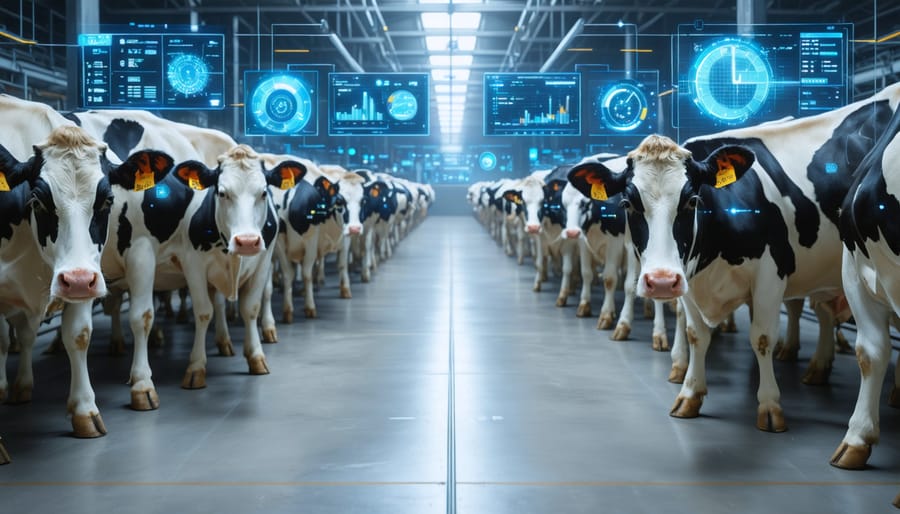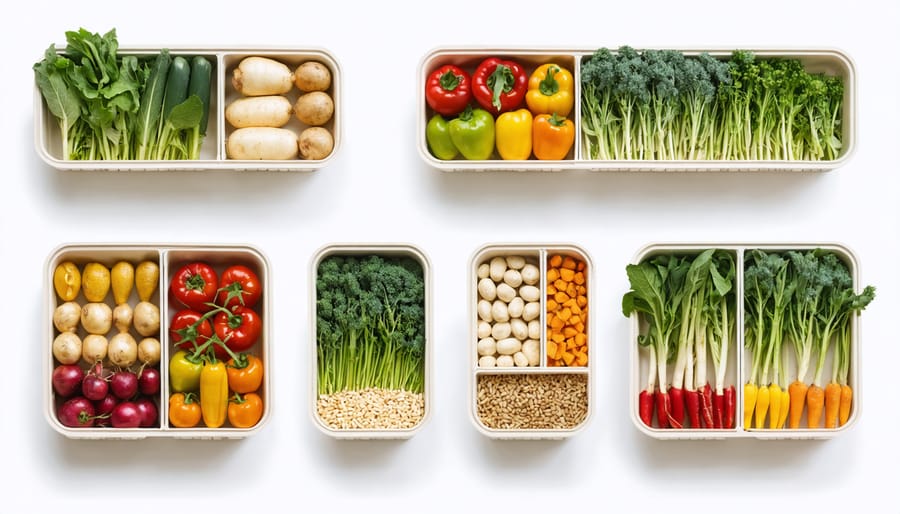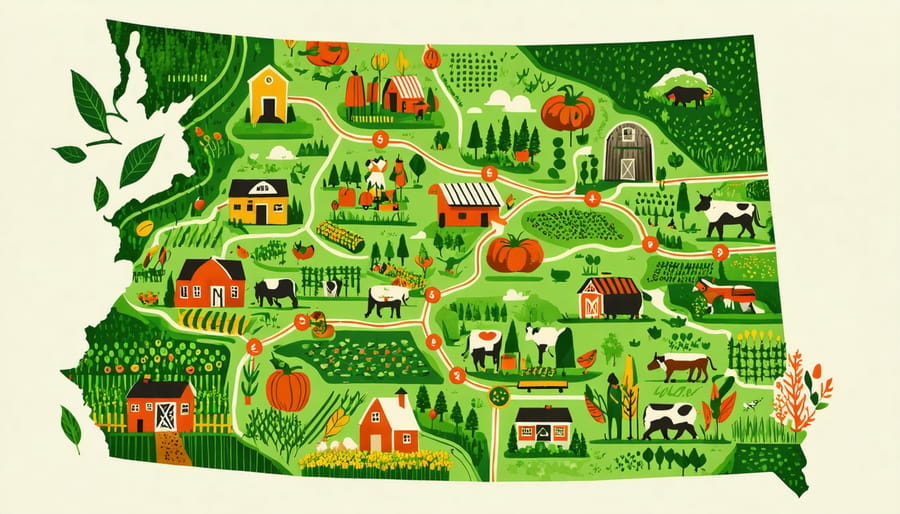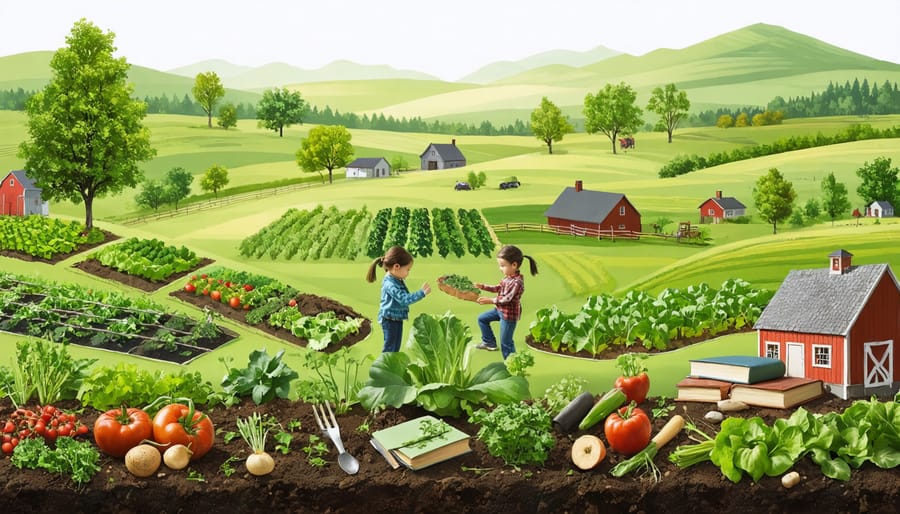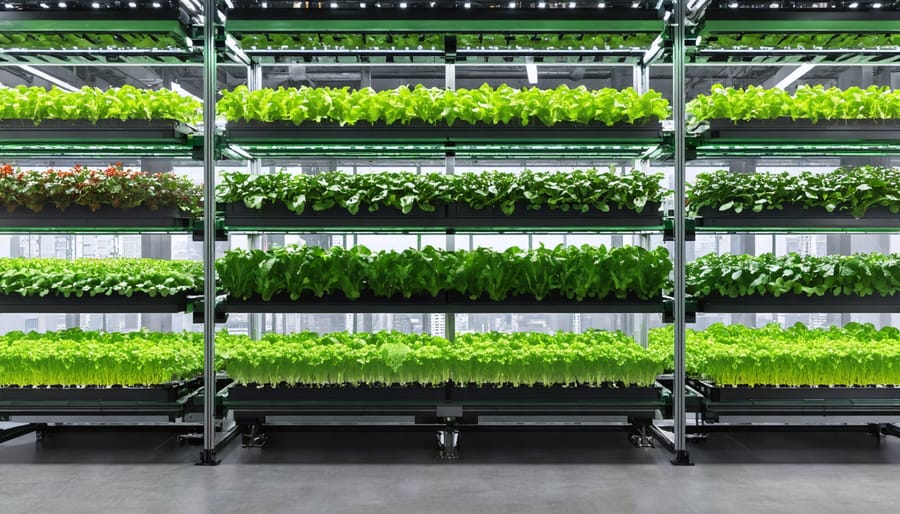Modern dairy farm technology is revolutionizing how Canadian farmers produce milk, manage herds, and implement sustainable farming practices. From automated milking systems that operate 24/7 to AI-powered health monitoring that detects illness before visible symptoms appear, technology is transforming every aspect of dairy operations across Alberta’s landscape.
Advanced sensors now track individual cow performance, measuring everything from milk composition to rumination patterns, while robotic feed pushers ensure consistent nutrition delivery throughout the day. These innovations have helped local farmers increase production by 25% while reducing labour costs by nearly a third.
The integration of smart technology isn’t just about efficiency – it’s reshaping the entire dairy farming ecosystem. Real-time data analytics enable farmers to make precise decisions about breeding, feeding, and herd management, while automated climate control systems maintain optimal barn conditions year-round in our challenging Canadian climate.
For Alberta’s dairy community, embracing these technological advances means staying competitive in a rapidly evolving agricultural landscape while maintaining the highest standards of animal welfare and milk quality. The future of dairy farming is here, and it’s digital.
Precision Milking Systems Transform Alberta Dairies
Robotic Milking Solutions
Robotic milking systems have revolutionized dairy operations across Alberta, offering farmers increased flexibility and improved herd management capabilities. These automated systems typically operate 24/7, allowing cows to be milked on their natural schedule – typically 2.5 to 3 times per day – which has shown to increase milk production by up to 15% in many Alberta installations.
Local dairy farmer Mike Thompson of Red Deer County reports, “Since implementing robotic milking in 2019, we’ve seen not only increased production but also better cow health and reduced labour costs. The system pays attention to each individual cow’s needs and patterns.”
The technology uses advanced sensors to clean udders, attach teat cups, and monitor milk quality in real-time. Each cow wears a transponder that tracks vital health metrics, feeding patterns, and milk production data. This information helps farmers make informed decisions about herd management and individual animal care.
Initial investment for a robotic milking system typically ranges from $200,000 to $250,000 per unit, with each unit serving approximately 60 cows. While the upfront cost is significant, many Alberta farmers report reaching ROI within 5-7 years through labour savings and increased production efficiency.
The Alberta Milk Producer Association offers support programs and resources for farmers considering the transition to robotic milking, including connecting them with experienced producers who can share insights from their automation journey.
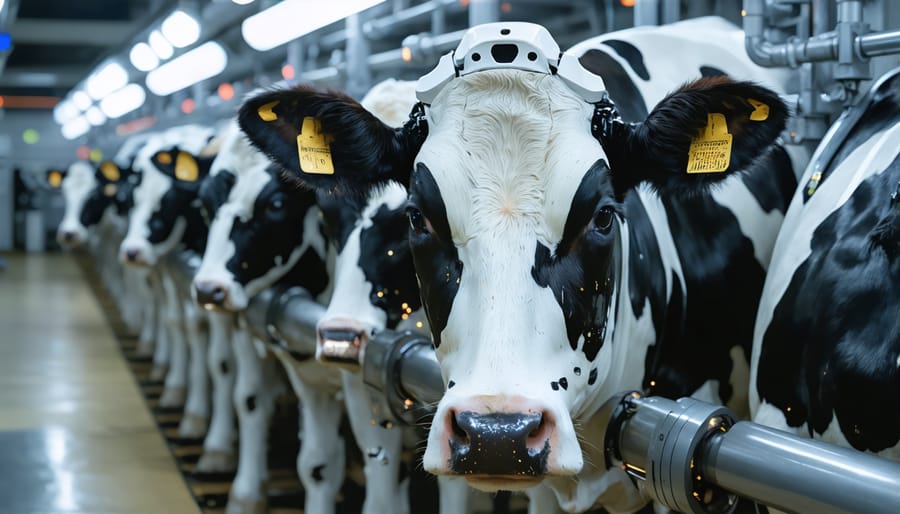
Data-Driven Herd Management
Modern dairy operations are increasingly turning to data-driven solutions to optimize herd management and boost productivity. These sophisticated monitoring systems track individual cow performance, health metrics, and behavioural patterns in real-time, providing farmers with actionable insights to make informed decisions.
At the heart of these systems are radio-frequency identification (RFID) tags and sensors that monitor vital statistics like milk production, body temperature, and activity levels. Many Alberta dairy farmers have reported significant improvements in detecting health issues early, with some operations seeing a 30% reduction in treatment costs through preventative care.
Advanced analytics platforms process this data to create detailed health profiles for each animal. For example, changes in rumination patterns or mobility can signal potential health concerns before visible symptoms appear. These early warning systems have proven particularly valuable during calving season, helping farmers provide timely intervention when needed.
The integration of artificial intelligence has further enhanced these capabilities. Machine learning algorithms can predict optimal breeding times, identify feed efficiency patterns, and even forecast potential health issues days in advance. Several dairy operations in central Alberta have successfully implemented these systems, reporting improved pregnancy rates and reduced veterinary costs.
For smaller operations, scalable solutions are available that focus on essential metrics while maintaining cost-effectiveness. Many producers start with basic activity monitoring and gradually expand their data collection capabilities as they see returns on their initial investment.
Environmental Control and Energy Efficiency
Smart Ventilation Systems
Modern dairy operations are increasingly turning to smart farming solutions for ventilation control, recognizing that optimal air quality directly impacts milk production and herd health. Here in Alberta, where temperatures can swing dramatically between seasons, sophisticated ventilation systems have become essential for maintaining consistent barn conditions.
These systems typically combine temperature sensors, humidity monitors, and automated controls to adjust airflow throughout the day. Many Alberta dairy farmers have reported up to 15% increases in milk production after installing smart ventilation systems that maintain temperatures between 5-20°C, the ideal range for dairy cattle comfort.
The latest ventilation technology includes variable-speed fans that automatically adjust based on real-time conditions. These systems work alongside natural ventilation features like ridge vents and sidewall curtains, creating a hybrid approach that’s both energy-efficient and effective. Motion sensors detect cattle movement patterns, triggering targeted ventilation in high-traffic areas to prevent heat stress.
Remote monitoring capabilities allow farmers to track and adjust barn conditions through smartphone apps, making it easier to maintain optimal environments even when off-site. Many systems also integrate with weather stations to anticipate and prepare for incoming weather changes, ensuring your herd stays comfortable regardless of external conditions.
Local success stories, like the Wilson Family Farm in Red Deer County, demonstrate how these ventilation innovations have helped reduce respiratory issues in their herd while cutting energy costs by nearly 30%.
Solar Integration for Dairy Operations
Several Alberta dairy farms are leading the way in solar energy adoption, demonstrating how this renewable technology can significantly reduce operational costs while supporting sustainable farming practices. The Vanden Broek Dairy Farm near Lethbridge serves as a prime example, having installed a 100-kilowatt solar array in 2019 that now offsets approximately 60% of their annual electricity consumption.
The system, which cost $285,000 to install, qualified for both provincial and federal green energy incentives, reducing the initial investment by nearly 40%. Owner Peter Vanden Broek reports an average monthly savings of $800 on electricity costs, with the system expected to pay for itself within eight years.
Similarly, the Mountain View Dairy operation near Olds implemented a 75-kilowatt system specifically designed to power their milking parlour and cooling systems. Owner Sarah Thompson notes, “The predictability of our energy costs has improved our financial planning significantly. Plus, we’re seeing consistent production even during Alberta’s notorious winter months.”
These successful implementations have sparked interest across the province, with the Alberta Milk Producers Association reporting that approximately 15% of dairy farms in the region now utilize some form of solar power. The association’s data suggests that farms implementing solar solutions typically see a 40-60% reduction in grid electricity consumption, with some achieving even higher savings during peak summer months.
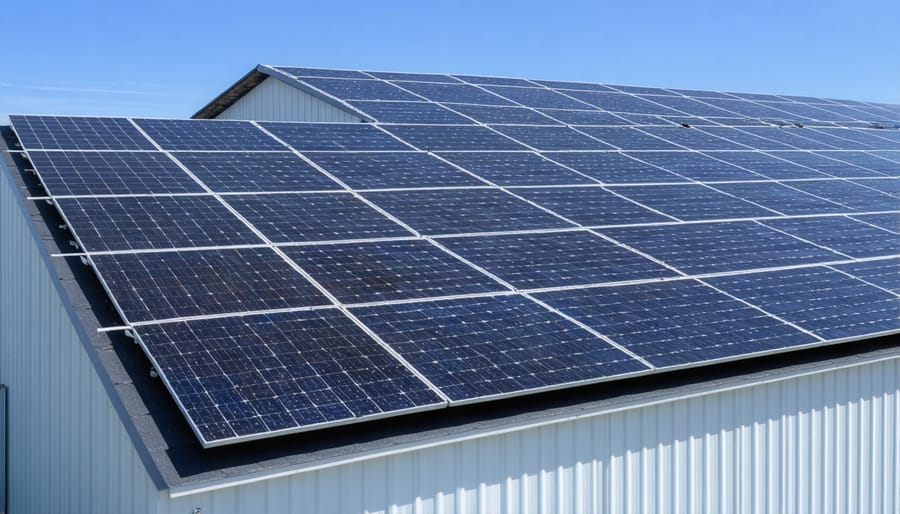
Waste Management Innovation
Automated Manure Management
Modern manure management systems have revolutionized how Alberta dairy farms handle waste while supporting environmental sustainability. Automated systems now integrate seamlessly with barn operations, utilizing scrapers, pumps, and sensors to efficiently collect and transport manure to storage facilities.
These smart systems can be programmed to operate on customized schedules, reducing labour costs while maintaining optimal barn cleanliness. Advanced separators divide solids from liquids, creating valuable components for different applications. The solid portion becomes premium compost, while the liquid fraction serves as nutrient-rich fertilizer for crops.
Many Alberta farmers have implemented innovative waste reduction strategies through automated composting systems. These units monitor temperature, moisture, and oxygen levels, ensuring optimal conditions for breaking down organic matter. The resulting compost not only provides additional revenue streams but also reduces environmental impact.
Real-time monitoring through mobile apps allows farmers to track system performance, receive maintenance alerts, and adjust operations remotely. This technology has helped local dairy operations reduce their carbon footprint while improving soil health through proper nutrient management. Some systems even capture methane for energy production, creating a closed-loop system that benefits both the environment and farm economics.
Water Recycling Systems
Water conservation has become a cornerstone of modern dairy operations, with innovative recycling systems leading the charge in sustainable farm management. Many Alberta dairy farms have adopted advanced water recycling technologies that can reduce freshwater consumption by up to 50%.
The most common system involves a three-stage filtration process that treats and reuses water from milk pre-cooling and equipment washing. This cleaned water can then be repurposed for barn cleaning, irrigation, or returning to holding tanks for equipment sanitization.
At the Vermilion Research Farm, dairy operator Sarah Thompson implemented a closed-loop water system that saves approximately 15,000 litres of water daily. “We’ve seen significant cost savings, and it’s rewarding to know we’re doing our part for environmental stewardship,” Thompson notes.
Plate coolers, which use well water to pre-cool milk before it enters bulk tanks, exemplify efficient water use. The warmed water from this process can be collected and used for cattle drinking water, especially beneficial during winter months when animals prefer slightly warmed water.
Modern monitoring systems with real-time sensors help farmers track water usage patterns and quickly identify potential leaks or inefficiencies, ensuring optimal system performance while maintaining strict hygiene standards.
Feed Management Technology
Precision Feed Systems
Modern precision feed systems have revolutionized how dairy farms manage their herds’ nutrition, offering unprecedented accuracy and efficiency in feed delivery. These automated systems use sophisticated software to calculate individual feed rations based on factors like milk production, lactation stage, and body condition score.
At the Green Valley Dairy in Olds, Alberta, implementing a precision feed system reduced feed waste by 12% while increasing milk production by 8% within the first year. The system uses RFID technology to identify each cow and dispense precisely measured feed portions throughout the day, ensuring optimal nutrition timing.
These systems typically include automated feed mixers, conveyor belts, and individual feeding stations. Smart sensors monitor feed consumption patterns and adjust portions accordingly, while real-time data analytics help farmers make informed decisions about feed formulations and purchasing.
Beyond efficiency, precision feeding supports better herd health through consistent nutrition. The technology prevents over-and under-feeding, reducing the risk of metabolic disorders common in dairy cattle. Alberta farmers report fewer displaced abomasums and ketosis cases after implementing these systems.
The initial investment in precision feeding technology is offset by reduced labour costs, improved feed efficiency, and enhanced milk production. Many Canadian farmers have accessed federal and provincial funding programs to help with implementation costs, making the technology more accessible for operations of various sizes.
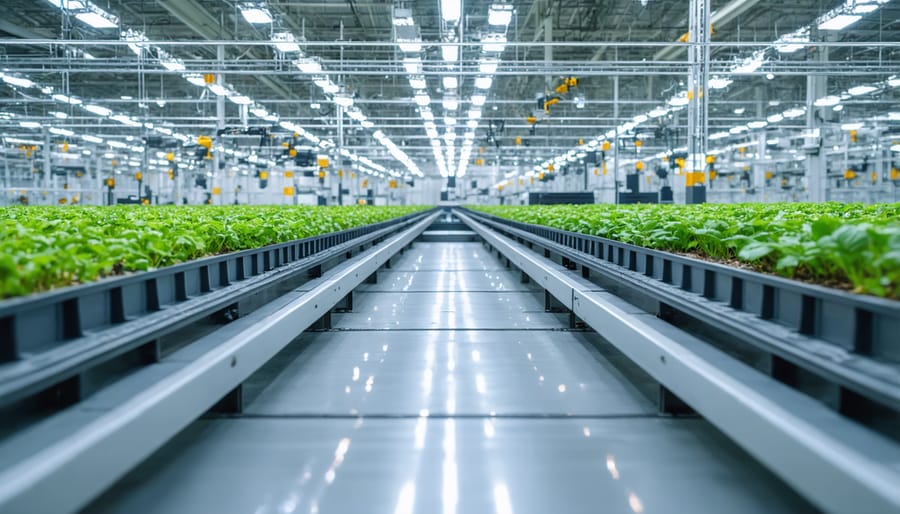
Feed Quality Monitoring
Modern feed quality monitoring systems have revolutionized how Alberta dairy farmers optimize their herds’ nutrition. Digital NIR (Near-Infrared) analyzers now allow farmers to test feed composition right on the farm, providing instant readings of protein, moisture, and fiber content. These portable devices help farmers make immediate adjustments to feed ratios, ensuring consistent milk production and herd health.
Smart feed management systems track daily consumption patterns and automatically adjust rations based on individual cow needs. Many Alberta farmers are incorporating automated feed pushers that ensure constant feed availability while reducing waste by up to 75% compared to traditional methods.
Real-time moisture sensors in silage bunkers help monitor fermentation quality and alert farmers to potential issues before they affect feed quality. These systems, combined with weather-resistant feed bins equipped with load cells, provide precise inventory management and help maintain optimal feed freshness.
Advanced laboratory services across Alberta now offer comprehensive feed analysis using mass spectrometry and DNA sequencing to detect harmful mycotoxins and optimize nutrient profiles. Local success stories include the Peterson family farm in Red Deer, which increased milk production by 12% after implementing precision feed monitoring technology.
Regular feed quality monitoring also supports sustainability goals by reducing waste and improving feed conversion efficiency. Many farms report cost savings of 15-20% on feed expenses while maintaining or improving milk production quality.
The adoption of dairy farm technology represents a transformative shift in Canadian agriculture, offering unprecedented opportunities for efficiency, sustainability, and profitability. As we’ve explored throughout this article, these innovations are revolutionizing everything from milk production to herd management, while contributing significantly to our local agricultural economy.
The integration of automated milking systems, precision feeding technology, and data-driven decision-making tools has demonstrated remarkable returns on investment for Alberta dairy farmers. With average productivity increases of 15-20% and labor cost reductions of up to 30%, these technologies are proving essential for farm sustainability and growth.
Looking ahead, the future of dairy farming technology appears even more promising. Emerging innovations in artificial intelligence, blockchain for supply chain transparency, and advanced sensor technologies are set to further revolutionize the industry. We can expect to see more sophisticated robot-assisted operations, enhanced environmental monitoring systems, and improved animal welfare technologies within the next decade.
For Alberta’s dairy farmers, embracing these technological advances while maintaining our strong community values and sustainable practices will be key to future success. The support networks, educational resources, and funding opportunities available through local agricultural organizations make this transition both accessible and achievable for farms of all sizes.
By continuing to adapt and implement these innovative solutions, our dairy farming community is well-positioned to meet the growing demands of consumers while ensuring the long-term viability of our operations. The future of dairy farming in Alberta is bright, powered by technology but grounded in our commitment to quality, sustainability, and community values.

